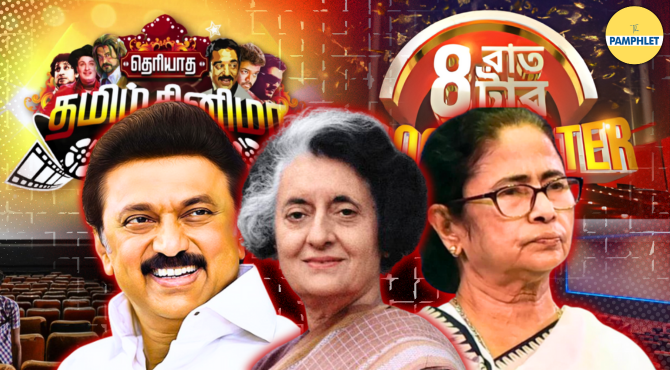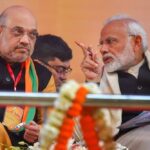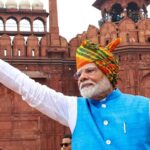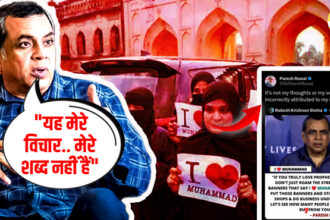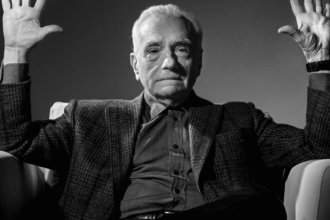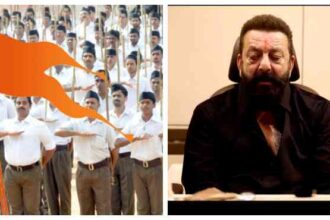In Tamil Nadu, cinema is not considered an art form. It’s a government wing, just with better production design.
The line might sound sarcastic, but actress and political figure Gautami Tadimalla recently said something close to that. In a rare, unfiltered statement, she alleged that the DMK family’s grip over the Tamil film industry is so deep that it not only decides what gets made, but also who gets to exist within it.
According to Gautami, who is also AIADMK’s propaganda secretary, Kamal Haasan’s former partner, and a veteran actress, production houses, distribution chains, and even theatres operate under the shadow of one extended political network. Those who are politically neutral, or worse, aligned with the opposition, quietly disappear from opportunity. The result?
Not creative competition, but ideological conformity — curated in Dolby sound.
It’s a claim few in Tamil cinema would publicly contest, even if many privately agree. Because in this state, the camera doesn’t just capture stories; it manufactures loyalty.
Cinema: The softest tool of control
Politicians have long recognized that nothing manipulates emotions quite like art. You can ban books and censor speeches — but the movie screen doesn’t shout, it seduces.
Cinema’s power lies in how subtly it normalizes ideology. A song becomes a language of pride. A villain’s accent becomes a cue for prejudice. A patriotic line turns a politician into a savior.
Repeat it across decades, and you don’t need propaganda offices — you have multiplexes.
The Tamil model: Family, franchise, film
Tamil Nadu’s political establishment understood this early, perhaps earlier than anyone else in India.
The DMK wasn’t just a party born out of the Dravidian movement; it was the first to weaponize cinema as the mass delivery system of ideology.
From C.N. Annadurai’s screenplays to M. Karunanidhi’s dialogues, the party didn’t use cinema as PR. It was a cinema. From the 1950s onwards, film stars weren’t celebrities; they were political prototypes. M.G. Ramachandran (MGR) and Jayalalithaa turned fan clubs into vote banks, blurring the line between stardom and statehood.
That tradition continues. Today, Udhayanidhi Stalin, the heir to the DMK throne, is not only a politician but also an actor, producer, and distributor. And as Gautami pointed out, in this vertically integrated ecosystem, refusing to align politically doesn’t make you independent; it makes you unemployable.
The Bengal version: Campaign curated to a culture
If Tamil Nadu made cinema its ideological engine, West Bengal turned art into a marketing department. The Trinamool Congress (TMC) doesn’t bother with symbolism; it runs culture like a state-funded PR machine.
Every film festival, award ceremony, and state-sponsored show carries the imprint of Aroop Biswas, the minister who unofficially serves as the cultural gatekeeper of Bengal.
Who gets funding, who gets a release slot, and who headlines a panel — the decisions are less artistic and more administrative. Actors like Nusrat Jahan, Mimi Chakraborty, and Dev are no longer seen as performers, but as curated representations of “modern Bengal”, English-speaking, camera-ready, politically correct.
When filmmaker Anik Dutta’s satirical Bhobishyoter Bhoot was quietly pulled from theatres in 2019, the official reason was “technical issues.” But everyone in Kolkata knew it wasn’t the sound that was faulty — it was the politics.
The land that once produced Satyajit Ray, where cinema once questioned power, now rewards silence.
The Congress blueprint: The original script
Decades before DMK and TMC discovered soft control, Congress wrote the manual. No party in independent India has shaped and censored cultural production more systematically than this one.
During the Emergency (1975–77), Indira Gandhi’s government turned art into a tool of obedience.
- Playwright Utpal Dutt was jailed for satirical theatre.
- Singer Kishore Kumar was banned from All India Radio for refusing to perform propaganda songs.
- Actor Dev Anand, once close to Congress, was blacklisted for criticizing censorship.
That wasn’t an aberration — it was a pattern. For Congress, art wasn’t about freedom of expression; it was about managed emotion.
The relationship between cinema and power deepened under Rajiv Gandhi, whose friendship with Amitabh Bachchan turned political charisma into a pop-culture spectacle.
Later, in the UPA years, films like Raajneeti revived that soft legacy — blending dynastic morality with cinematic gravitas. The narrative was straightforward: Congress may falter, but its ideals remain pure.
The party no longer needed censorship; it had established influence networks, film festivals, award committees, and media circles that shaped what was praised and what was deemed “problematic.” Remember that dialogue, ‘Sarkaar tumhari hui toh kya hua, system toh humara hai!’
The great irony
Every era has its own censorship. Some regimes use bans. Others use applause.
In Tamil Nadu, the film roll begins and ends with one surname. In Bengal, state sponsorship determines artistic relevance. In Delhi, legacy networks still dictate what counts as “liberal art.”
And yet, the loudest voices crying “fascism” today are the same ones who once silenced artists, blackballed singers, and jailed playwrights. They preach freedom, but own the copyright to it.
The truth is, censorship no longer needs a file or a decree. It only needs applause from the right audience and silence from the rest.
In India, art rarely dies by force — it dies by invitation.

